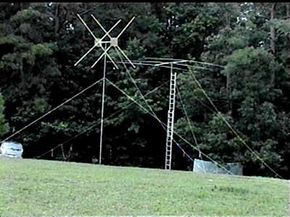Antennas
Little whip antennas, wire antennas in trees, and antennas atop a tower are all used, depending on the frequency in use. Some antennas are made of wire strung between trees. Be sure to use lightning protection for outside antennas! Lower frequencies have longer wavelengths. Longer wavelengths need larger antennas. A single antennas can be used to transmit and receive.
The common 146-MHz (2-meter) antenna is a 19-inch quarter-wave whip. A wavelength at 146 MHz is approximately 2 meters, and a quarter wave of 2 meters is about 19 inches (50 cm). Hams enjoy the fun of experimenting with various types of antennas.
Advertisement
Hams, including the writer of this article, have communicated with other hams using the following types of antennas with antenna tuners:
- Metal window screens in upper floors of hotels and motels
- Aluminum extension ladders, insulated from the ground, leaning against a house (the lower the frequency, the longer the ladder)
- Soldered-together rain gutters and downspouts
- Flat copper tape hidden behind wallpapered walls
- Extended Slinky toys supported by a rope through the middle of an attic
- Camera-tripod-supported whip antenna
- Disguised flagpoles fed with buried coaxial cable
- Fine wires cast with a fishing rod between dormitory buildings
What Keeps Ham Operators From Transmitting on the Same Frequency?
Many hams can be on the same frequency, but it depends on the propagation factors. VHF and UHF are line-of-sight, so many hams can be on the same frequency in one state. On short-wave bands, radios have variable frequency tuning to allow moving your transmitted signal (in very small increments) in between two other transmitting stations. Hams often do a lot more listening than transmitting. Often, they listen for another ham that identifies the station as being in a sought-after county, state, or country.

Hams may collect confirmations of contacts using QSL cards—postcard-like notes confirming two-way communication that the two radio operators send to each other in the mail. VHF and UHF hand-held radios typically use channeled communications, using selectable fixed frequencies.
